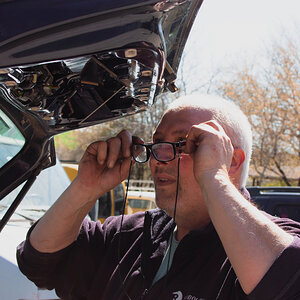Navigation
Install the app
How to install the app on iOS
Follow along with the video below to see how to install our site as a web app on your home screen.

Note: This feature currently requires accessing the site using the built-in Safari browser.
More options
You are using an out of date browser. It may not display this or other websites correctly.
You should upgrade or use an alternative browser.
You should upgrade or use an alternative browser.
F/stops and lighting?
- Thread starter Sarah23
- Start date
- Joined
- Dec 16, 2003
- Messages
- 33,896
- Reaction score
- 1,853
- Location
- Edmonton
- Website
- www.mikehodson.ca
- Can others edit my Photos
- Photos NOT OK to edit
On what?Ok...stupid question time again...where is the guide number?
It's usually on a flash somewhere and certainly in the spec sheet/manual.
The 430EX has a guild number of 43 meters (that's convenient)...which is 141 feet. And that's at ISO 100.
Also, the Guide number will change, based on the zoom setting of the flash head.
From HEREGuide number (power output).
The unit has a zooming flash head which moves internally to adjust for the lens focal length. Control over the zoom position is both manual and automatic. The zoom range is from 24-105 mm, with zoom detents (stops) at 24, 28, 35, 50, 70, 80 and 105mm.
The flash zoom function is capable of taking the camera’s image sensor size into account if the camera is also capable of transmitting that data to the flash unit. In such a case the flash can adjust its zoom to match a reduced (less than 35mm film frame) sensor size, and so wastes a minimum of light around the edges.
The unit’s guide number (provided in metres, not feet, for ISO 100) varies depending on the zoom head settings.
At 14mm (with the flip-down diffuser in place) the guide number is 11.
At 24mm the guide number is 25.
At 28mm the guide number is 27.
At 35mm the guide number is 31.
At 50mm the guide number is 34.
At 70mm the guide number is 37.
At 80mm the guide number is 40.
At 105mm the guide number is 43.
Sarah23
TPF Noob!
- Joined
- Mar 3, 2008
- Messages
- 716
- Reaction score
- 0
- Location
- Oklahoma
- Can others edit my Photos
- Photos NOT OK to edit
On what?
It's usually on a flash somewhere and certainly in the spec sheet/manual.
The 430EX has a guild number of 43 meters (that's convenient)...which is 141 feet. And that's at ISO 100.
Also, the Guide number will change, based on the zoom setting of the flash head.
From HERE
ya, on the flash itself.
- Joined
- Dec 16, 2003
- Messages
- 33,896
- Reaction score
- 1,853
- Location
- Edmonton
- Website
- www.mikehodson.ca
- Can others edit my Photos
- Photos NOT OK to edit
Also, keep in mind that the Guide Number is the flash at full power.
Helen B
TPF Noob!
- Joined
- Sep 16, 2007
- Messages
- 3,296
- Reaction score
- 467
- Location
- Hell's Kitchen, New York
- Can others edit my Photos
- Photos NOT OK to edit
The guide number for your flash/strobe should be in the manual. It will be different for different power settings and for different zoom settings (if the flash zooms). (Which flash do you have?)
VI has already given the basics, so here's a bit more.
As VI wrote,
GN = N x Dfs
or
N = GN/Dfs
Where
N is the f-number
Dfs is the distance from the flash to the subject, and
GN is the guide number.
This works so simply because the intensity of the flash beam drops off with the inverse of the square of the distance - ie the intensity at 16 ft will be one quarter of the intensity at 8 ft. This fits in neatly with the f-number - f/8 lets in four times as much light as f/16 (in simple terms).
The guide number and the distance both have to be in the same units, so GN is always quoted as a distance, eg "The guide number for this flash is 200 feet at ISO 100" or "The guide number for this flash is 60 metres at ISO 100." Saying "The guide number for this flash is 30 at ISO 100" is like saying "This field is 127 long."
The distance should be measured along the light path, so if you are bouncing the flash off the ceiling for example, you need to account for the distance from the flash to the spot on the ceiling where the centre of the beam will hit, then from there to the subject. You then calculate the f-number from that distance, and subtract one or one-and-a-half stops to allow for the reflectance of the ceiling, if the ceiling is near white. It sounds harder than it is - you just need estimates most of the time.
Guide numbers are usually given for interiors - ie they allow for some reflection from the surroundings. If you are outside, or in a large hall, you may need to open up a stop from the f-number calculated from the guide number to compensate for the absence of reflections from the walls and ceiling.
The guide number is independent of the lens you have on the camera, unless the flash has auto zoom - because the guide number is dependent on the zoom setting of the flash. Some manufacturers now quote the guide number at the full zoom setting - ie they make the flash look more powerful. The Metz 76, for example, is less powerful than the Metz 60. The Metz 60 has a GN of 60 metres (at ISO 100) with a coverage equivalent to a 35 mm lens, the Metz 76 has a GN of 76 metres with a coverage equivalent to a 105 mm lens (its maximum zoom).
At a coverage equivalent to a 50 mm lens, the GN of the Metz 76 comes down to 54 m at ISO 100 - already less powerful than the Metz 60.
Therefore, it is important to know what zoom setting is used by the manufacturer when the GN is quoted when you compare flashes.
Best,
Helen
VI has already given the basics, so here's a bit more.
As VI wrote,
GN = N x Dfs
or
N = GN/Dfs
Where
N is the f-number
Dfs is the distance from the flash to the subject, and
GN is the guide number.
This works so simply because the intensity of the flash beam drops off with the inverse of the square of the distance - ie the intensity at 16 ft will be one quarter of the intensity at 8 ft. This fits in neatly with the f-number - f/8 lets in four times as much light as f/16 (in simple terms).
The guide number and the distance both have to be in the same units, so GN is always quoted as a distance, eg "The guide number for this flash is 200 feet at ISO 100" or "The guide number for this flash is 60 metres at ISO 100." Saying "The guide number for this flash is 30 at ISO 100" is like saying "This field is 127 long."
The distance should be measured along the light path, so if you are bouncing the flash off the ceiling for example, you need to account for the distance from the flash to the spot on the ceiling where the centre of the beam will hit, then from there to the subject. You then calculate the f-number from that distance, and subtract one or one-and-a-half stops to allow for the reflectance of the ceiling, if the ceiling is near white. It sounds harder than it is - you just need estimates most of the time.
Guide numbers are usually given for interiors - ie they allow for some reflection from the surroundings. If you are outside, or in a large hall, you may need to open up a stop from the f-number calculated from the guide number to compensate for the absence of reflections from the walls and ceiling.
The guide number is independent of the lens you have on the camera, unless the flash has auto zoom - because the guide number is dependent on the zoom setting of the flash. Some manufacturers now quote the guide number at the full zoom setting - ie they make the flash look more powerful. The Metz 76, for example, is less powerful than the Metz 60. The Metz 60 has a GN of 60 metres (at ISO 100) with a coverage equivalent to a 35 mm lens, the Metz 76 has a GN of 76 metres with a coverage equivalent to a 105 mm lens (its maximum zoom).
At a coverage equivalent to a 50 mm lens, the GN of the Metz 76 comes down to 54 m at ISO 100 - already less powerful than the Metz 60.
Therefore, it is important to know what zoom setting is used by the manufacturer when the GN is quoted when you compare flashes.
Best,
Helen
Village Idiot
No longer a newbie, moving up!
- Joined
- Mar 20, 2008
- Messages
- 7,269
- Reaction score
- 406
- Location
- Shepherdsturd, WV / Almost, MD
- Can others edit my Photos
- Photos NOT OK to edit
Also, keep in mind that the Guide Number is the flash at full power.
So if you want to shoot at half power on the 430, you shoot at half of 141', 70.5'. If you want to shoot at 1/4 power, you half the guide number again - 35.25'.
So 1/4 power and at distance of 5' from the subject, the aperture would be close to?
f/stp = 35.25 / distance(5')
f/7.05
I guess that's one of the reason I like photography, it's technical as well as creative.
Helen B
TPF Noob!
- Joined
- Sep 16, 2007
- Messages
- 3,296
- Reaction score
- 467
- Location
- Hell's Kitchen, New York
- Can others edit my Photos
- Photos NOT OK to edit
So if you want to shoot at half power on the 430, you shoot at half of 141', 70.5'. If you want to shoot at 1/4 power, you half the guide number again - 35.25'.
Er, are you sure about that? It's a square thing, you know.
If full power is a GN of 141 feet, half power is a GN of 100 feet. 141 divided by root 2 (1.414) is 100.*
*Edit: The same relationship holds for film speed. If the quoted GN is 60 metres at ISO 100, it will be 84 metres at ISO 200, 120 metres at ISO 400, and 42 metres at ISO 50.
Best,
Helen
bigalbest
TPF Noob!
- Joined
- Jun 5, 2008
- Messages
- 505
- Reaction score
- 0
- Location
- Litchfield Park, AZ
- Website
- www.sandphotos.blogspot.com
- Can others edit my Photos
- Photos OK to edit
All of this becomes easier to understand with time and practice. Set your flashes and take a shot, see what happens. With speedlights power settings and distance from subject become second nature with a little experience. Try using just one flash to start with two can be a little confusing.
Sarah23
TPF Noob!
- Joined
- Mar 3, 2008
- Messages
- 716
- Reaction score
- 0
- Location
- Oklahoma
- Can others edit my Photos
- Photos NOT OK to edit
Wow...maybe I need to go take some math classes...hahaha!
OOOOK....well I am still incredible confused.
Lets try this...I work best with hands on or examples, and since I am not close enough to any of you to be able for you to SHOW me, lets use an example.
Say I am doing a portrait, indoors, with my 50mm lens. I have my one flash on a light stand, and its about 10 feet from the subject. (no umbrella or gels or anything) I am wanting to use an aperture of 5.6. WHAT DO I DO FROM HERE? Is this even a example that will work?
OOOOK....well I am still incredible confused.
Lets try this...I work best with hands on or examples, and since I am not close enough to any of you to be able for you to SHOW me, lets use an example.
Say I am doing a portrait, indoors, with my 50mm lens. I have my one flash on a light stand, and its about 10 feet from the subject. (no umbrella or gels or anything) I am wanting to use an aperture of 5.6. WHAT DO I DO FROM HERE? Is this even a example that will work?
- Joined
- Dec 16, 2003
- Messages
- 33,896
- Reaction score
- 1,853
- Location
- Edmonton
- Website
- www.mikehodson.ca
- Can others edit my Photos
- Photos NOT OK to edit
Don't sweat it. This stuff can be very technical...it's not imperative that you have a full understanding of it. As suggested, just practice, practice, practice. You will eventually get a better 'feel' for what works and what doesn't. And that's what really counts. The numbers may or may not sink in over time...but it will get easier to understand...I promise.I am so confused. I'm sorry...I'm sure it's frustrating trying to explain this to me...It's just not clicking.
- Joined
- Dec 16, 2003
- Messages
- 33,896
- Reaction score
- 1,853
- Location
- Edmonton
- Website
- www.mikehodson.ca
- Can others edit my Photos
- Photos NOT OK to edit
With digital, it's fairly easy because you can guess and test. Just fire a test shot, maybe starting at 1/2 or 1/4 power (on the flash) and adjust it from there.Say I am doing a portrait, indoors, with my 50mm lens. I have my one flash on a light stand, and its about 10 feet from the subject. (no umbrella or gels or anything) I am wanting to use an aperture of 5.6. WHAT DO I DO FROM HERE? Is this even a example that will work?
If you had a flash meter, you would use the meter to fire the flash and see what light you were getting at the subject. If the reading was F16 (for example) then you would turn the flash down 3 stops (F16 to F5.6 is three stops). So that would be 1/8 power setting on the flash.
You could use the GN of the flash to figure it out. A GN of 141' divided by your distance of 10' is 14.1...so that would be your aperture for proper exposure (remember that is at full power and 105mm zoom setting). F5.6 is just less than three stops from F14.1...you you could turn down your flash by 2 1/2 stops (give or take) and that would get you pretty close. Of course, you could change the zoom setting and use a different GN. You could also move the flash closer or farther as mentioned before.
Helen B
TPF Noob!
- Joined
- Sep 16, 2007
- Messages
- 3,296
- Reaction score
- 467
- Location
- Hell's Kitchen, New York
- Can others edit my Photos
- Photos NOT OK to edit
10 feet times 5.6 is 56 feet, so you want a power output equivalent to 56 feet, or 17 m. Let's say that you are using ISO 100. From the data that Mike gave, the 430EX has a GN of 34 m at ISO 100 at the 50 mm setting. (see note) That's more than you want. The GN is twice what you need.
You can either move the flash back another 10 ft to 20 ft (and hence get a harsher direct light) or you could cut the flash power to one quarter. Cutting the power by one quarter halves the GN.
Note on zoom settings. All the flashes I've used (and I haven't used many Canon ones, so please correct me if I'm wrong) do not compensate for 'crop factor'. The 50 mm setting covers a 50 mm lens on a full frame camera. If you can adjust the zoom setting independently of the lens data provided by the camera, you could take this into account, and set a higher zoom setting, for example 70 mm if you are using a 50 mm lens on a Rebel XTi. The coverage also depends on the position of the flash, not the position of the camera.
Best,
Helen
You can either move the flash back another 10 ft to 20 ft (and hence get a harsher direct light) or you could cut the flash power to one quarter. Cutting the power by one quarter halves the GN.
Note on zoom settings. All the flashes I've used (and I haven't used many Canon ones, so please correct me if I'm wrong) do not compensate for 'crop factor'. The 50 mm setting covers a 50 mm lens on a full frame camera. If you can adjust the zoom setting independently of the lens data provided by the camera, you could take this into account, and set a higher zoom setting, for example 70 mm if you are using a 50 mm lens on a Rebel XTi. The coverage also depends on the position of the flash, not the position of the camera.
Best,
Helen
Village Idiot
No longer a newbie, moving up!
- Joined
- Mar 20, 2008
- Messages
- 7,269
- Reaction score
- 406
- Location
- Shepherdsturd, WV / Almost, MD
- Can others edit my Photos
- Photos NOT OK to edit
Er, are you sure about that? It's a square thing, you know.
If full power is a GN of 141 feet, half power is a GN of 100 feet. 141 divided by root 2 (1.414) is 100.*
*Edit: The same relationship holds for film speed. If the quoted GN is 60 metres at ISO 100, it will be 84 metres at ISO 200, 120 metres at ISO 400, and 42 metres at ISO 50.
Best,
Helen
oops, you're right.
Sarah23
TPF Noob!
- Joined
- Mar 3, 2008
- Messages
- 716
- Reaction score
- 0
- Location
- Oklahoma
- Can others edit my Photos
- Photos NOT OK to edit
Oooooo....ok...I think I am starting to get it.
So depending on what mm setting I have the flash on (lets just say 50mm) I then use that corresponding guide number (which was 34 I believe) in the F=GN/D equation...correct? So if I WANTED to use an aperture of 5.6...I would divide 34 by 10 (if its 10feet) and get 3.4 (which would be the aperture)...so to get the aperture at 5.6, I would move the light closer?
Is that anywhere close to right?
So depending on what mm setting I have the flash on (lets just say 50mm) I then use that corresponding guide number (which was 34 I believe) in the F=GN/D equation...correct? So if I WANTED to use an aperture of 5.6...I would divide 34 by 10 (if its 10feet) and get 3.4 (which would be the aperture)...so to get the aperture at 5.6, I would move the light closer?
Is that anywhere close to right?
Similar threads
- Replies
- 13
- Views
- 307
- Replies
- 7
- Views
- 243
- Replies
- 21
- Views
- 2K
- Replies
- 16
- Views
- 1K
- Replies
- 0
- Views
- 319

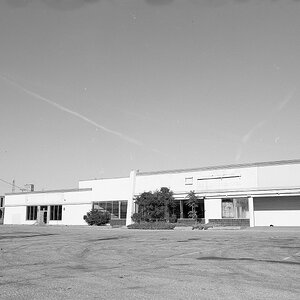
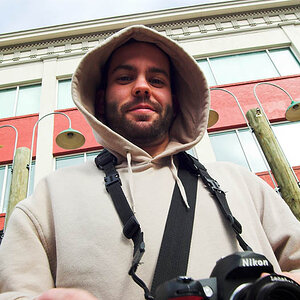
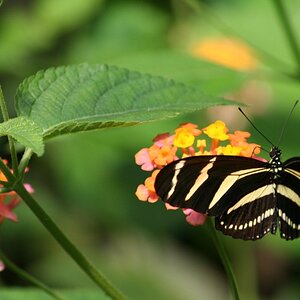
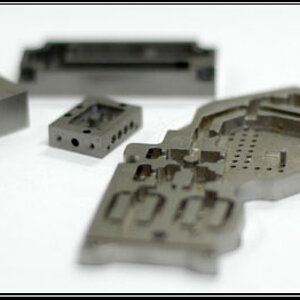
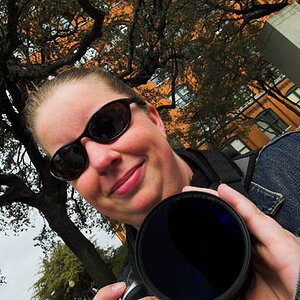
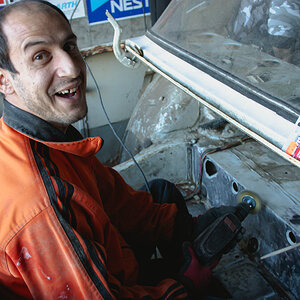
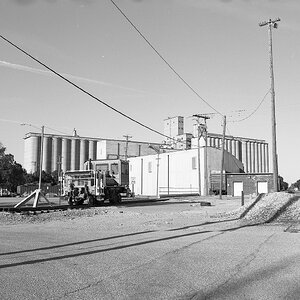

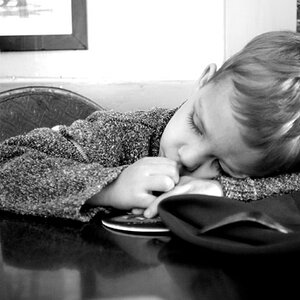
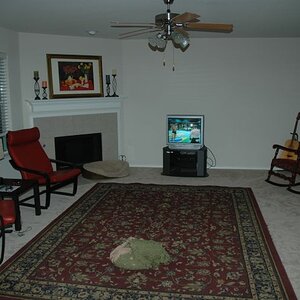
![[No title]](/data/xfmg/thumbnail/35/35224-c14babe4157e05767660f47e7de82aef.jpg?1619736959)
